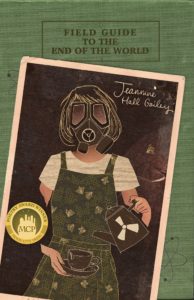
Let’s say you’re old enough to remember 1987 when American rock band R.E.M. first proclaimed, “It’s the End of the World as We Know It (And I Feel Fine).” Let’s say you’ve sung along to this song dozens of times—into hair brushes and broom handles, at karaoke nights with your friends. It felt good, didn’t it, blithely belting out that apocalyptic chorus, taking it all for granted that the world could really end? You weren’t afraid of any true disaster, not then. You could look catastrophe square in the eyes without blinking because most catastrophes you ever thought of were purely hypothetical—the stuff of myths or the rantings of conspiracy theorists. It would be years before you even realized you never learned the rest of the words to that song.
Now let’s say it’s 2017 in Trump’s America. You’re driving to work, and you can’t bear another inflammatory sound bite, another eerie and absurdist news story—part dystopian fiction, part reality TV. So you switch to a music station, hoping to steady your nerves, and that’s when it happens: “It’s the End of the World as We Know It” pours through your speakers like flood water. For the first time in thirty years, something catches in your throat, renders you speechless, songless. For the first time in thirty years, you fear you really aren’t fine—that nothing and no one around you is, either.
Here’s the good news: someone has written a book that speaks to everything you are feeling right now, a book to address your grief, your anxiety, your pangs of hopelessness as well as your wish to be hopeful again. Though published two months before the 2016 presidential election, no collection I’ve encountered to date could have been more prescient, more finger-to-the-pulse of our present zeitgeist than Jeannine Hall Gailey’s Field Guide to the End of the World (Moon City Press, 2016). Just listen:
In these close cramped quarters we travel
together, the human race, one man kicking the seat
and another, too close, pinching my arm.
The sky-blue Plymouth of our lives is lined
in sticky vinyl and no one is playing the music
I like. Overhead the screams of vultures, but someone
shouts It’s a hawk! And someone else is playing
twenty questions, asking What is the mind of God?
Which way are we heading?
See what I mean?
I recommend you pull over now. Better yet, I recommend you call in sick and turn your car around. You’re going to want to read this book in one solitary burst, descending poem by poem through Gailey’s expertly rendered literary katabasis. Her poet-speaker is both companion and guide on your journey, both mentor and friend as you tread the five-pronged path through forests such as these: Disaster Studies, Cultural Anthropology, Hard Science, A Primer for Your Personal Genome Project, and End Times Eschatology. And though Gailey’s speaker doesn’t feel fine about the end of the world either—far from it—in her you’ll find resistance embodied, a mind and voice that refuse passivity in the face of any threat.
“I don’t do nostalgia, my darling,” this speaker cautions in one poem, so no chance she’s going to pretend the past was all sweet-smelling, parasite-free, organic roses, either.
Then, in another, the plain-spoken acknowledgment: “It’s not the life you planned.” Now we realize our poet-cicerone is speaking to us and as us at the same time:
______________________________________How our minds
and bodies spin apart, like hives of bees confused about whom to follow,
flying further and further out to discover—what? That they’d flown
too far and now are frozen, flightless. How many hives abandoned.
We cannot sleep too far from disaster zones.
Notice, in this representative passage, Gailey’s close attention to language—in particular her assemblage of fricatives (confused, follow, flying further, flown, far, frozen, flightless…). The fricative is a consonant sound, that eff sound fittingly heard in effed up and effed now, made by a friction of breath that results in a turbulent air flow. For poets, these lines epitomize what we mean by the union of sound and meaning. Specific, well-placed fricatives evoke both the literal and symbolic turbulence at hand.
Notice also how Gailey nests our human experience in context of the larger “Nature,” to which we all belong. By smart analogies, seismic juxtapositions, and subtle recursions, she extends and explores this pattern of human-as-nature and nature-as-human throughout the book. She also subverts our expectations by incorporating the post-human and the other-worldy into the landscape of the natural world—entities which already reside and replicate within contemporary lore. Keep your eyes peeled for these poems: “Introduction to Teen Girl Vampires,” “Supervillain Studies: For the Love of Ivy,” “Zombie Stripped Clones: They are Not Regenerating,” and “Introduction to Conducting an Alien Autopsy.”
Have I piqued your interest now?
When I was growing up in Seattle, I remember how we made earthquake kits, fending off fear with preparations for when the “Big One” hit. Now, as an adult in Miami, we make hurricane kits, anticipating a range of tropical threats. I suppose in Topeka they make cyclone kits, and in Boulder, avalanche kits. But wherever you live, you’re always bracing for some kind of natural disaster—mudslides, tsunamis, tornados, wildfires.
Field Guide to the End of the World anticipates and articulates disasters of the physical world in benchmark poems like “In Case,” “Lessons in Emergency,” and “Introduction to Solar Weather, on Valentine’s Day.” At the same time, this capacious vade mecum reminds us of the ways we are always already immersed in disasters of the social, cultural, and political realms. From“As Venus and Jupiter Come Together, We Fall Apart”:
I bang my head against the landscape;
suburban sprawl out every window, fires burning on the television.
How many churches destroyed? How many of us spinning apart?
and from “Introduction to Spy Narrative as Love Story”:
It’s time
at last to switch allegiances, identities, change costumes and passports
before I become one more silhouette forgotten, one more asset turned
agent provocateur, blowback from missing your hard target.
and from “An Introduction to Salvation”:
We keep building bombs,
lighting fires, pulling dead children from dead women in muddy fields.
Do you claim your hands are clean? But look at the blood
you’ve spilled just to get here. You’ll never be quite free
not matter how you pray. You’ll never claw the scales from your eyes.
Readers are not exempt from any emotional experience in Field Guide, including our own fraught accountability in the family of beings. We are never permitted to forget that we happen to the world just as it happens to us.
But—have I mentioned the humor yet?
You were feeling so broken and listless on your drive to work, and I promised you a book that isn’t mere enumeration of reasons for doom and gloom. There is such innovation in Gailey’s work, such commitment to resilience, a ceaseless sifting through rubble in search of precious stones.
“Martha Stewart’s Guide to Apocalypse Living” is one such gem:
Survival skills are just like hostess skills: a little preparation, a little spying with
the drones, a little determined defense-driven hedging of the grounds. Razor
wire goes beautifully with your holly thicket.
The same is true of “Post-Apocalypse Postcard (with Anthropologie Catalog)”:
We’re looking picturesque, holding a woven bamboo suitcase as the future
dissipates like a $40 fig fragrance diffuser, the children concentrating on braiding
bracelets, all of our jaunty sunglasses stacked against the glare of the coming—
Aren’t you feeling a little better now?
And because Gailey draws from every discipline, every site and source of popular and unpopular culture, I don’t think she would mind me likening her Field Guide to Mary Poppins’ magical carpet bag.
Remember how our titular guide keeps reaching deeper and deeper inside that bag, producing everything from a house plant (evidence of growth!) to a hat stand (sturdy column of specific nouns on which to hang more abstract ideas!) to a mirror (for reflection, of course!) and a lamp (the bright moments of insight that recursively arise!)?
Well, this book is similarly limitless, similarly generative, just as gamut-spanning, just as practical and whimsical alike. In other words, you won’t be bored when you read it, and you won’t be sad. Rather, as you read, you’ll find yourself reclaiming your sense of wonder.
I hope you’re home by now. I hope you’ve found the deepest solace this collection can afford. Perhaps you’ve reached a later, tender poem like “Remnant,” or would like to turn there now:
I knew I was home when I walked down a path
of decaying leaves, through a bridge of tree limbs […]_________________________the chance of finding
really good wild strawberries there, little patches of violets,
the trinkets of divestment. You never get lonely in the woods.
Then, in the final poem, “Epilogue: A Story for After,” Gailey begins a new chapter, which she leaves the reader to finish:
I want to tell you a story about how we survived the end of the world. Crouched
around a dying fire, I illustrate with shadow puppets the old, beat-up van, the
velocity of water and sky, the unnamable odds against us.
She has sent up a flare in the aftermath of something awful. We grasp the kite-tail of the hope we have been missing, and with our other hand, we release a measure of the not-fine-ness we have come to accept as status quo. Gailey has a knack for placing all of us in context: “we were not here first, we will not be here last”—but we are here now. And now, she reminds us, is not nothing—not idle, not indifferent, not without a will to change and grow.
The most probing question I found in this collection: “What, in the end, is essential baggage?” One right answer is Field Guide to the End of the World.
The most probing meta-question I found in this collection: “What could I write now/ that would do anything?” One right answer is Field Guide to the End of the World.
The book you are holding in your hands is as timely and timeless as any volume of poems could be. It belongs in your toolbox, your backpack, your attic or your storm cellar or your secret room under the stairs—a provision to help you fend off fear with preparation. But you’ll want two copies—another for your coffee table or your nightstand, somewhere close at hand. Think of it as a talisman to have at the ready the next time you decide to watch the news.
***
Note: One poem from Field Guide to the End of the World, “Introduction to the Limits of Metaphor (A Love Poem),” was first published in The Rumpus in 2014. I submit the link here as an early harbinger of the project that has since come to such luminous fruition.





